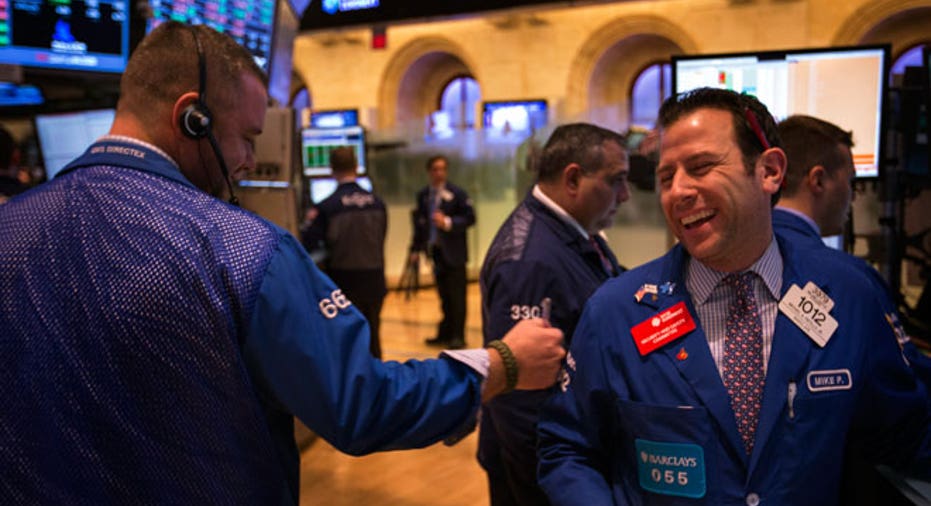Wall Street Surges but Caps Week in the Red

U.S. equity markets extended momentum from a European rally, ending near session highs, as beaten down banks and oil markets saw relief.
The Dow Jones Industrial Average was 313 points higher, or 2% to 15973. The S&P 500 gained 35 points, or 1.95% to 1864, while the Nasdaq Composite added 70 points, or 1.66% to 4337.
Financials, materials and energy led nine of 10 S&P 500 sectors in positive territory, a reversal from the prior session in which they were the biggest decliners. Utilities, meanwhile, barely slipped into the red.
Today’s Markets
Wall Street capped a tumultuous week on a high note Friday as equities followed European markets higher thanks to a rebound in bank shares, which have so far weighed heavily on sentiment this year.
German-headquartered Commerzbank shares jumped about 14% after the company reported it returned to profit last quarter and posted higher revenue, with the expectation for a profit increase in 2016.
“Considering how Deutsche Bank had faired earlier in the week, this morning’s impressive Commerzbank results have caught traders by surprise,” IG market analyst Alastair McCaig said in a note.
The results helped spur a rebound in European bank shares. The Stoxx Europe 600 bank sub index on Friday rose 2.78%, though it was still firmly in negative territory for the week, on track to post losses of 4.26%.
In the U.S., the financial sector has suffered the most of the 10 S&P 500 sectors for the week. It was set for declines of nearly 3%, as worries over global interest rates turning increasingly negative will hit bank stocks and financial entities. However, after Friday’s relief rally, those losses were more than halved from 6% declines expected for the week at Thursday’s close.
In an effort to restore confidence in the sector, late Thursday night, JPMorgan Chase (NYSE:JPM) CEO Jamie Dimon said he bought up 500,000 of the bank’s shares for $26 million.
Shares of the biggest U.S. investment bank traded up more than 8% alongside its peers. Bank of America (NYSE:BAC), Wells Fargo (NYSE:WFC), Citigroup (NYSE:C), and Goldman Sachs (NYSE:GS) all traded solidly in positive territory.
Despite the positive momentum in the U.S. and Europe, overnight Japan’s Nikkei suffered steep declines after reopening following a day off, while China markets remained closed in observance of the Chinese New Year.
Despite the late-week rally, the major averages still booked weekly losses, though they were substantially lower than expected at the close of trade on Thursday. The Dow saw weekly declines of 1.43%, while the S&P shed 1.95%, and the Nasdaq lost 0.58%.
Elsewhere in the market, oil prices continued to find momentum, surging on continued optimism of a possible deal among OPEC members to cut production in an effort to stabilize prices, which have seen declines of more than 48% from the same period a year ago. On Thursday, the Wall Street Journal reported the United Arab Emirates’ energy minister said OPEC members are “ready to cooperate on a cut, but current prices are already forcing producers outside the group to at least cap output prices.”
Oil prices built on that optimism Friday, as West Texas Intermediate crude surged 12.32% to settle at $29.44 a barrel. Brent, the international benchmark, jumped 10.98% to $33.36 a barrel.
“Movement is occurring toward a production deal as certain OPEC members come under enormous financial strain (Venezuela is thought to be on the brink). It is notable that Russia and Iran appear willing to compromise although the most important party involved, Saudi Arabia, has been relatively silent in public on the subject,” Larry Shover, chief investment strategist at Solutions Fund Group, said.
Still, for the week, oil booked substantial losses. U.S. crude erased 4.69%, while Brent slashed 2.06% over the five-day period.
As traders flocked to riskier assets Friday, gold prices, which saw a hefty rally in the prior session, trimmed Thursday’s gains of 4.45%. The safe-haven commodity lost 0.71% in recent action, to trade down to $1,239 a troy ounce. Thursday’s rally was attributed mostly to Federal Reserve Chief Janet Yellen’s remarks in front of the Senate Banking Committee in which she said the U.S. central bank would not take negative rates off the table for consideration of monetary policy.
“Gold bugs might well have been pinching themselves yesterday to ensure it wasn’t all a dream. But today’s price action is arguably even more important,” McCaig said. “To foster the belief that a corner might finally have been turned, the precious metal needs to ensure it doesn’t go into reverse today.”
Gold saw it’s biggest one-week percentage gain since 2008, and its longest winning streak since April 2015, up four-consecutive weeks.
The yield on the benchmark 10-year U.S. Treasury bond rose 0.092 percentage point to 1.736%. Yields move in the opposite direction of prices.
On the economic front, the calendar was fairly busy after a quiet data week. Traders parsed figures from the Labor Department which showed import prices dropped 1.1% last month, a smaller fall than the 1.4% decline expected. Export prices, meanwhile, slipped 0.8%, compared to expectations for a 0.9% decline.
Retail sales data from the Commerce Department showed shoppers spent at a slightly faster pace than expected in January. Retail sales rose 0.2% during the period, compared to expectations for a 0.1% rise. Excluding the volatile autos component, sales rose 0.1%, compared to unchanged expectations.
Meanwhile, a gauge of consumer sentiment from the University of Michigan dropped to 90.7 in February from a reading of 92 in January. Expectations had been for it to hold steady.